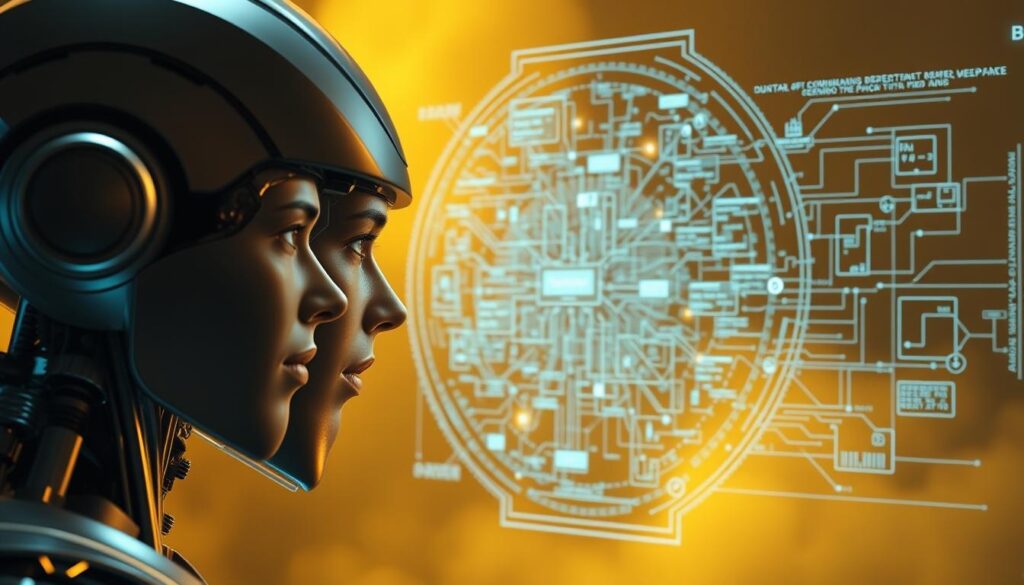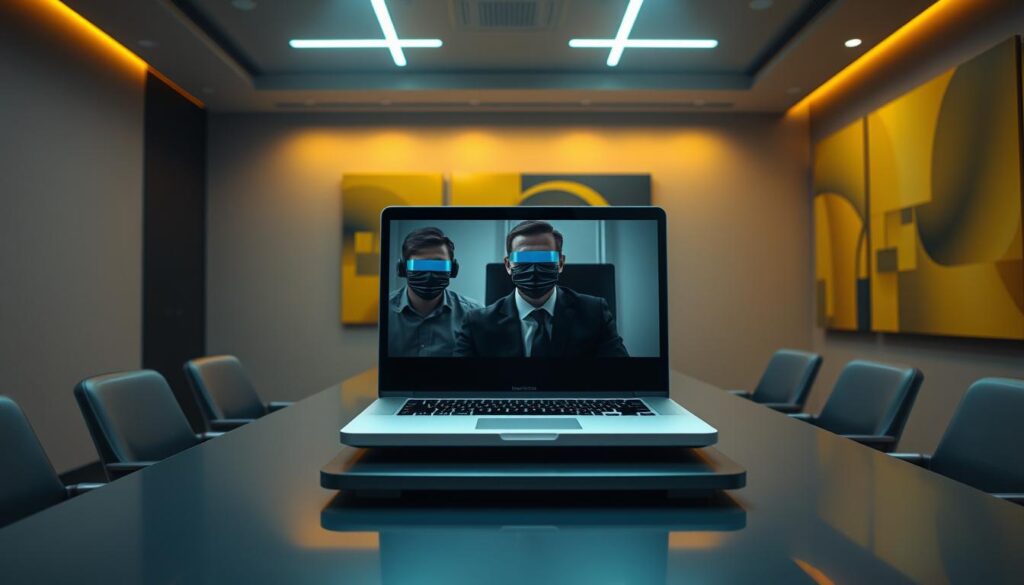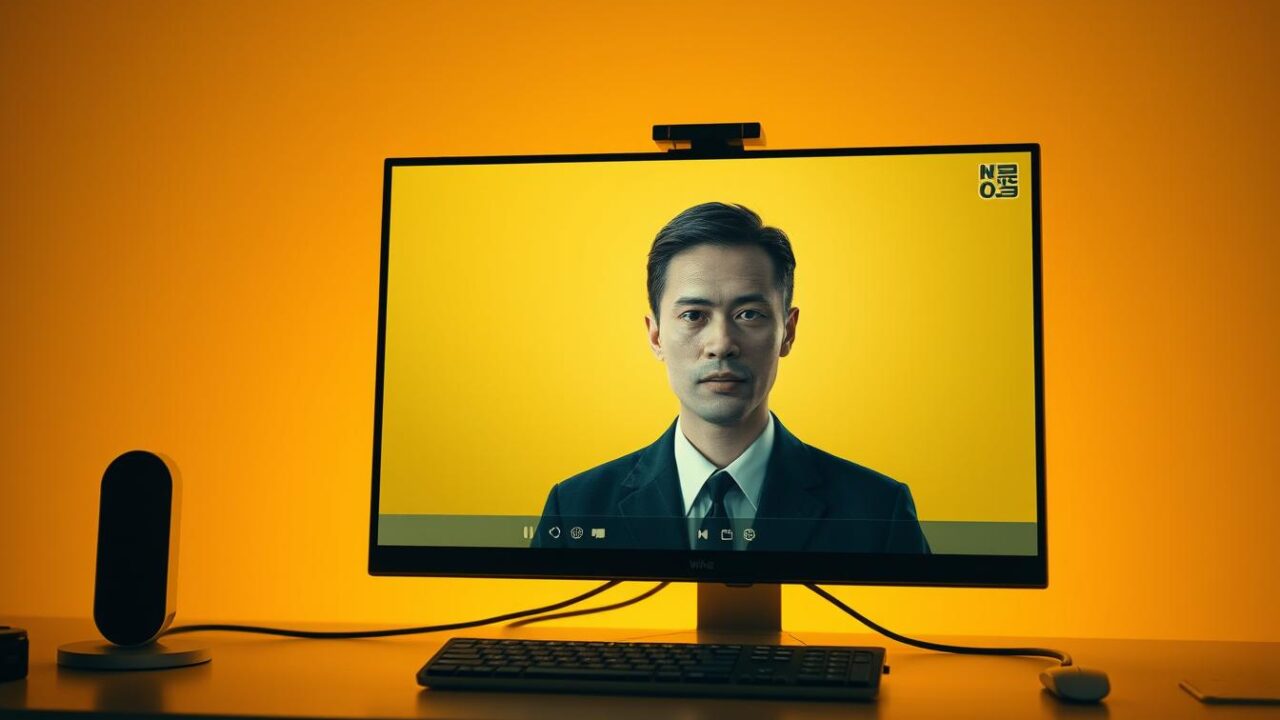Research firm Gartner says by 2028, 25% of job applicants will be fake. They use deepfake technology and AI to trick hiring managers in remote interviews. As tools for making synthetic media get better and easier to use, companies are finding it hard to tell real candidates from fake ones.
Deepfakes in video interviews have made hiring more complicated and uncertain. Candidates are using generative AI to change their resumes, voices, and video avatars. Malicious actors aim to install malware or reveal security flaws through these tricks. This new threat requires companies to be more careful and have strong plans to protect the hiring process.
Key Takeaways
- Gartner estimates 25% of job applicants will be fake by 2028, using deepfake technology
- AI-powered video manipulation enables candidates to impersonate others in interviews
- Synthetic media creation tools make it easier for malicious actors to deceive hiring managers
- Organisations face challenges in distinguishing genuine applicants from AI-generated fakes
- Robust strategies are needed to combat deepfakes and ensure recruitment integrity
The Rise of Deepfakes in Remote Job Interviews

Remote work is becoming more common, but it brings a new problem: deepfakes in job interviews. Thanks to AI and machine learning, scammers can make ai-generated applicants that look very real. These can trick even the most skilled recruiters.
Deepfakes in remote job interviews worry companies all over the world. They can look, sound, and act like real people. This makes it hard to tell who’s real and who’s not.
Hiring Managers Face New Challenges with AI-Generated Applicants
Deepfakes have changed how recruiters screen candidates. Old ways of interviewing don’t work anymore. Now, they need to use deepfake detection algorithms and better video interview security.
Gartner Predicts 25% of Job Applicants Will Be Fake by 2028
A Gartner report says 25% of job seekers will be fake by 2028. This is a big warning for companies to fight deepfake fraud. They must keep up with AI advancements and use new detection tools.
How Fraudsters Conduct Deepfake Interviews

Remote job interviews are now common, and fraudsters have found ways to trick hiring managers. They use stolen personal info and deepfake tools to make fake video interviews. These interviews look real, making it hard to tell them apart from real ones.
Fraudsters start by getting stolen personal info like names and addresses. They use this to create fake online profiles and resumes. They then apply for jobs, aiming for IT and programming roles to get to valuable data.
Scammers Exploit Stolen Personal Information and Deepfake Videos
When they get a video interview invite, fraudsters use deepfake tech to pretend to be the fake candidate. They swap their faces and voices with the stolen identities. This makes it hard for hiring managers to spot the fake during remote interviews.
Accessible Tools Make Deepfake Technology Easier to Use
Deepfake tools are now easy for fraudsters to use. These tools help them make fake videos and sounds without needing much tech skill. This makes it easier for more scammers to use deepfake interviews to trick people.
To fight this, companies need to be careful and check the identity of job applicants well. They should use strong checks and teach hiring managers to spot deepfake scams. This way, they can protect themselves from these clever scams.
Deepfake Technology to Impersonate Candidates in Video Interviews

Deepfake technology has brought a new threat to remote job interviews. It allows scammers to use AI to make fake videos of job applicants. This can trick hiring managers and let fraudsters get into sensitive company info.
Scammers mix stolen personal data with deepfake tech to make fake interviews. These look and sound just like real job applicants. It’s hard for companies to spot the fake ones.
To fight this, companies need to focus on stopping identity fraud in hiring. They can use things like multi-factor authentication. This means asking for ID along with the video interview to check if it’s real.
They should also use biometric authentication like facial and voice checks. This way, they can compare the interviewee’s data with real records. This helps spot and stop deepfake scams.
As deepfake tech gets better, companies must stay alert and update their checks. This is key to keeping their hiring safe from fraud and keeping their processes honest.
The Threat to British Universities
British universities are facing a new challenge as they use automated systems for international student applications. This has led to the rise of deepfake applicants. These AI-created personas aim to trick admissions officers and get into UK universities fraudulently.
Enroly, a software used by many British universities, has found a worrying trend. In January, they spotted about 30 deepfake applicants out of 20,000 interviews. This shows how deepfake technology is becoming a problem in online interviews.
The numbers might seem small, but the threat is real. As more universities use online interviews, the risk of fraud grows. This could harm the trust in the admissions process.
Enroly Uncovers Deepfake Applicants in Automated Interview Processes
Enroly’s software has been key in catching deepfake applicants trying to get into British universities. It checks facial expressions, speech, and other details to spot fraud. This helps admissions teams review these cases carefully.
This finding shows universities need to be careful and take steps to stop online interview scams. As deepfake tech gets better, universities must keep up to protect their admissions. Only real applicants should be allowed in.
Small but Growing Trend of Deception in Online Interviews
Even though only a few deepfake applicants have been caught, it’s a worrying trend. Experts say as deepfake tech gets more advanced, more scams will happen. This is a big concern for the future.
To fight this, British universities need to invest in better detection tools. They should also train staff to spot deepfake applicants. By keeping up with AI and deepfake tech, universities can protect their admissions from fraud.
Real-World Examples of Deepfake Scams
Deepfake technology is getting better, making it hard to tell real from fake. This has led to more scams using deepfakes for money. For example, the head of WPP, the biggest ad company, was tricked in a deepfake call.
The scammer called the CEO, pretending to be a top person from a big company. They used AI to sound and look like the real person. They tried to get important info and make bad business choices.
This shows how deepfakes are getting smarter and can be used badly. It’s important for us to be careful and know how to spot these scams. Here are some ways to stay safe:
- Teach people about deepfake scams
- Use extra checks for important calls
- Use AI to find and stop deepfakes
By being alert and informed, we can avoid falling for these scams. This helps keep us safe from these clever tricks.
Methods Used to Detect Deepfake Fraud
Organisations are fighting back against deepfake fraud with advanced tech and strategies. They use top tools and watch closely to spot and stop these fake attacks. This helps keep remote job interviews and online chats safe from fraud.
Facial recognition tech is a key tool in fighting deepfake fraud. It checks faces for oddities that might show a fake. Also, matching faces with passport photos helps prove who’s real.
Flagging Unsatisfactory or Suspicious Interviews for Further Review
Spotting bad or fake interviews is also key. Companies like Enroly use systems to check video interviews for odd signs. If something looks off, the interview gets extra checks.
AI and machine learning help too. They look through lots of data for signs of fake videos. This keeps companies ahead of fraudsters and makes hiring safer.
Stopping deepfake fraud needs constant effort from companies. They must use the latest tech, follow strict rules, and check everything carefully. This way, they can protect their work and keep fraud out.
The Importance of Vetting International Applicants for UK Universities
UK universities have a big job when checking international students. They must keep their UKVI sponsorship licence by not saying no to more than 10% of students. If they fail, they could lose the right to sponsor international students.
Automated interviews help check how well students do and how well they speak English. But, deepfake technology has made things harder. Universities need to be extra careful to spot fake applications made with advanced AI.
Checking international students well is key for following UKVI rules and keeping the university’s reputation high. By finding and stopping deepfake scams, UK universities can make sure only real, qualified students get in.
As more students from around the world apply, UK universities must stay alert and update their checks. Using new tech and human skills together helps them deal with deepfakes. This way, they keep the trust of students and the government.
FBI Warns of Increased Use of Deepfakes in Remote Job Applications
The Federal Bureau of Investigation (FBI) has warned about deepfakes in remote job applications. They are mainly targeting IT and programming roles. Criminals use deepfake technology to impersonate candidates in video interviews, aiming to access sensitive data.
These scams use stolen personal info and AI-generated videos to create fake digital personas. Fraudsters apply for jobs that give them access to customer data and financial info. They can cause big financial losses and data breaches by getting hired.
Criminals Target IT and Programming Roles for Access to Sensitive Data
The FBI warns that IT and programming roles are being targeted by deepfakes. These jobs give access to critical systems and data, making them a big risk. With more remote work, the chance of falling for deepfake job scams has gone up.
Vidoc Security, a startup, almost hired two imposters using deepfakes. They caught the scam in the second interview, thanks to video evidence. This shows how important it is to be careful and aware of deepfake technology in hiring.
To fight this threat, companies need to verify identities strongly and train their teams. They should use multi-factor authentication, do thorough background checks, and use AI detection tools. The FBI says being proactive is key to protect data and keep remote hiring safe from deepfake scams.
Strategies for Combating Fake Candidates
Deepfake technology is getting better and easier to use. Companies need to fight back against fake job applicants. They can do this by using a mix of tech and careful checks on applicants.
One clever way to spot deepfakes in video interviews is to ask candidates to turn sideways. This trick shows deepfakes’ weaknesses. They can’t create realistic 3D images of people. So, if a candidate shows their profile, it’s easy to spot if they’re a deepfake.
Scrutinising Digital Footprints
Checking a candidate’s online presence is also key. Look at their social media, professional networks, and other online info. If what they say doesn’t match their online life, it’s a warning sign.
Verifying Identity Documents
It’s crucial to check identity documents like passports or driver’s licences. Compare these with what the applicant says. Advanced systems can spot fake documents.
Posing Probing Questions
Ask tough questions in interviews to test a candidate’s knowledge. Questions about specific technical details or unique experiences can reveal if they’re telling the truth. Deepfakes might not be able to answer these well.
Using these methods can help protect against fake job applicants. Being careful, using technology, and checking applicants well are vital. Deepfakes are a big threat to hiring processes, but with the right steps, we can fight back.
Specialised Remote Interview Software Solutions
Deepfake impersonation in remote job interviews is a growing threat. Specialised remote interview software is now available to fight this. These tools use artificial intelligence to spot impersonation and fraud, making hiring safer and more reliable.
These advanced platforms use AI to detect impersonation through behaviour analysis. They look at facial expressions, gestures, and demeanour. This helps spot deepfake use by finding inconsistencies in human behaviour.
Voice Analysis to Identify Indicators of Dishonesty
Specialised software also uses voice analysis to find dishonesty. It checks speech patterns, tone, and other vocal cues. This helps identify if a candidate is not telling the truth.
As remote interviews grow, using this software is key for companies. It helps protect against deepfake fraud. By using these tools, companies can hire genuine talent that fits their values and goals.
Conclusion
Deepfake technology is advancing fast, causing worries about its misuse in video interviews. Fraudsters are getting better at pretending to be candidates. This makes it hard for employers to keep their hiring processes safe.
Companies need to take action to protect themselves. They should use new security methods and ways to spot fake candidates. This includes using AI to check for fake voices and verifying identities.
It’s important for businesses to stay alert to deepfake technology’s growth. They should keep learning about it and improve their ways to catch fraud. This way, they can keep their hiring safe and build trust with everyone involved.
Want to hire me as a Consultant? Head to Channel as a Service and book a meeting.

